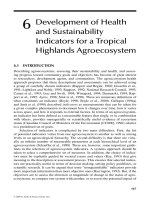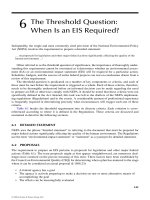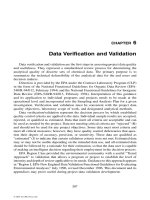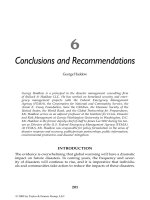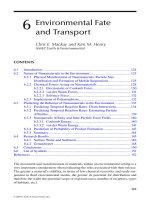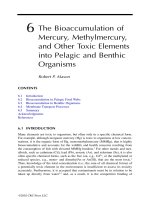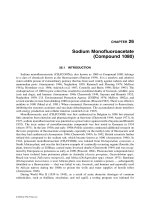AERATION: Principles and Practice ( VOLUME 11 ) - Chapter 6 pdf
Bạn đang xem bản rút gọn của tài liệu. Xem và tải ngay bản đầy đủ của tài liệu tại đây (3.99 MB, 32 trang )
© 2002 by CRC Press LLC
High-Purity
Oxygen Aeration
The use of pure oxygen instead of air significantly increases the oxygen mass transfer
driving force for aeration. Figure 6.1 shows a schematic of the increased driving
force available for oxygen transfer at 20°C. With a 100 percent oxygen gas phase,
the saturation value is increased from 9.09 to 43.4 mg/L. This value provides a
driving force for transfer almost five times greater for the pure oxygen system and
allows for design of a somewhat higher DO in the aeration tanks. The objective of
high-purity oxygen (HPO) systems is to provide higher gas phase oxygen concen-
trations than air systems, allowing faster treatment rates with higher mixed liquor
suspended solids and smaller aeration tanks. Figure 6.2 and the following section
trace the development of this system into a commercially viable aeration process
for activated sludge systems.
6.1 HISTORY
6.1.1 I
NITIAL
D
EVELOPMENTS
Before 1940, oxygen generation costs were prohibitively high for use in wastewater
treatment. Due to the possibility of a breakthrough in the manufacture of cheap
oxygen, Pirnie (1948) suggested a method developed the following year by Okun
(1949) at Harvard. Using an upflow fluidized bed reactor with preoxygenation of
the wastewater, Okun obtained 90 percent removal at MLSS concentrations of
5000–8000 mg/L. He found no marked difference in microbial biomass. Later,
from laboratory studies, Okun (1957) concluded that the only benefits were to
eliminate anoxic conditions in aeration tanks. Use of the process was thought
economically unfeasible due to low oxygen transfer efficiencies in aeration tanks
(Okun and Lynn, 1956).
In 1953, Budd and Lambeth (1957), under the auspices of Dorr-Oliver, conducted
studies on a 55–160 m
3
/d (8–30 gpm) bio-precipitation pilot plant at Baltimore’s
Black River treatment plant. Sludge settling characteristics were optimum at
. As a follow up to the Baltimore study, a more sophisti-
cated 270 – 380 m
3
/d (41 – 58 gpm) pilot plant incorporating fluctuating inflows
was constructed at Stamford, CT. A BOD removal efficiency of 90 percent was
obtained at an upflow rate of 36.7 m
3
/m
2
/d (900 gpd/sf). The power requirements
of this unit, including oxygen generation, were equal to those of a conventional
activated sludge plant while tank area requirements were reduced by as much as
50 percent and volume by 30 percent.
6
F
M
kgBOD
day kgMLSS
=−
−
02 04
5
© 2002 by CRC Press LLC
Robbins (1961) utilized Okun’s bioprecipitation process to treat Kraft mill sulfite
wastes. A BOD removal of 90 percent was obtained on this semi-chemical waste at
an in an eight-hour detention time. He suggested that the
capital investment would be less than that for a conventional plant. Pfeffer and
McKinney (1965) conducted oxygen enriched air laboratory studies on industrial
wastewater. They concluded that with the high transfer rates, the size and capital
investment of new plants could be reduced and for existing overloaded plants,
improved efficiency could be obtained without new tankage installation.
6.1.2 C
OVERED
T
ANK
D
EVELOPMENTS
To develop the HPO system into a commercially viable process, typically more than
90 percent of the oxygen must be transferred to the liquid phase due to the significant
cost of oxygen generation. Departing from the previous pilot studies, which used
preoxygenation of raw sewage, Union Carbide Corporation developed the UNOX
process using covered aeration tanks in series. Extensive full-scale (1–3 MGD)
studies, (Albertsson et al., 1970; Stamberg, 1972) were conducted at Batavia, NY
in 1969 to compare the performance of the UNOX
®
system to a parallel air system.
Oxygen was injected into the first stage of covered aeration tanks, flowing sequen-
tially from stage to stage in the headspace above the mixed liquor, until it was vented
from the last stage. Gas from the headspace was recycled to the mixed liquor in
each stage through hollow-shaft turbine aerators. In this closed system, the degree
of venting in the last stage was controlled to attain the desired 90 percent oxygen
utilization. This process provided the significant breakthrough in technology needed
to justify commercial development.
In comparison to the single-stage air system at Batavia, only one-third the
aeration time was required for the UNOX
®
system with a 30 percent reduction in
FIGURE 6.1
O
2
transfer schematic for air and high-purity oxygen.
F
M
kgBOD
da
y
k
g
MLSS
=
−
33
5
.
FIGURE 6.2
History of HPO system development.
Malcolm Pirnie
Dan Okun
Bio-precipitation Process
1949-1950’s
BENCH SCALE
1948
CONCEPT
PILOT & BENCH SCALE
1953 -1965
Budd & Lambeth- Dorr-Oliver
Baltimore & Stamford Pilot Plants
Robbins, Pfeffer & McKinney
Industrial Bench Scale
INITIAL DEVELOPMENT of HPO SYSTEM
FULL SCALE
COMPARISON
Union Carbide - Batavia
Covered Tanks - UNOX Process
1969
COMMERCIAL DEVELOPMENT
UNOX - Turbine & Surface Aerators
Industrial & Municipal Plants
1970 - 1989
COVERED TANK HPO SYSTEM DEVELOPMENT
1990 -
COVERED TANK- SURFACE
AERATORS
Lotepro - UNOX
®
; Kruger - Oases
®
OPEN TANK HPO SYSTEM DEVELOPMENT
1971-1990
PILOT & FULL SCALE
Martin Marietta (1971) - FMC(1980) - Zimpro
Marox™ System - Rotating Diffuser in Open Tank
Last in Operation 1990- Littleton/Englewood, CO
COMMERCIAL DEVELOPMENT
OPEN TANK- FLOATING HOOD
Praxair - In-Situ Oxygenator (I-SO™)
Mainly Industrial Plants
1995 -
© 2002 by CRC Press LLC
© 2002 by CRC Press LLC
waste activated sludge. An economic comparison from plants from 6 to 100 MGD
indicated that UNOX
®
costs would be, respectively, 80 to 70 percent the costs for
air systems, due mainly to reduced sludge disposal requirements. This reduction
provided the incentive for construction of numerous full-scale industrial and munic-
ipal plants using turbine and later surface aerators (Figure 6.3). For large cities, the
reduced land area requirements continue to make this process attractive. In 1976,
(Brenner, 1977) indicates that 152 covered plants were operational, under construc-
tion or being designed, most in the U.S. Of the above, 16 plants were in Japan and
one each in Canada, Mexico, England, Germany, Denmark, Switzerland, and Bel-
gium. Approximately 25 percent of the plants were industrial treating 10 percent of
the total flow. Most of the covered plants utilized surface aerators with only seven
plants with submerged turbines. However, these latter were large municipal plants
comprising 30 percent of the total flow treated in covered tank HPO systems.
In 1981, the Lotepro Corporation, a subsidiary of Linde AG, obtained the
registered trademark UNOX
®
and became the provider of the UNOX
®
process. The
turbine aeration mode has been dropped from the product line due to costs. The
manufacturer’s brochures (Gilligan, 1998) indicate that 220–300 UNOX
®
systems
treating both municipal and industrial wastewater have been installed worldwide
since its introduction in the late 1960s. The latest emphasis (Gilligan, 1999) is on
the UNOX
®
Biological Nutrient Removal (BNR) design approach, as shown in
Figure 6.4. This approach incorporates flexibility for front-end anaerobic phospho-
rous removal, selector zones, single- or two-step nitrification and denitrification, and
an open reactor for the last stage to elevate the pH. Recently, BNR plants have been
constructed or upgraded in Monterrey, Mexico; Morgantown, NC; Lancaster, PA;
Mahoning County, OH; and Cedar Rapids, IA. The City of Hagerstown, MD plant
will be upgraded to include an anoxic/anaerobic step for front-end denitrification
and phosphorous removal and an open last stage for CO
2
stripping. The New Salem,
MA plant has a first stage selector to control bulking which can be run in either in
an anaerobic mode with a nitrogen blanket or in an oxic mode with oxygen in the
gas head-space.
Kruger, Inc., in the 1990s, provided a closed tank staged reactor process called
“Oases
®
”, developed previously by Air Products and Chemicals, Inc. The Kruger
website (Krugerworld.com, 1998), listed 39 Oases
®
processes in North America,
five treating pulp and paper wastewater and the remainder municipal. Kruger has
also replaced the original turbine aeration system in the Middlesex County Utilities
Authority (MCUA) plants in New Jersey, using Philadelphia mixers.
6.1.3 O
PEN
T
ANK
D
EVELOPMENTS
In 1971, development of an open tank HPO system was underway in Denver, CO by
Martin Marietta Company. Initially, a fixed fine bubble diffuser system creating minute
(~50–200
µ
) bubbles was utilized. This system provided a large surface for oxygen
transfer and a slow rise rate allowing high oxygen utilization without covering the tanks.
Further development of the system by FMC utilized a rotating diffuser that formed a
fine mist. A comparison at the Denver Metro plant (Fullerton and Pearlman, 1979),
FIGURE 6.3
Covered tank HPO systems (courtesy of Lotepro Corporation, Valhalla, NY, a subsidiary of Linde AG).
© 2002 by CRC Press LLC
FIGURE 6.4
Biological nutrient removal for covered tank HPO systems (courtesy of Lotepro Corporation, Valhalla, NY,
a subsidiary of Linde AG).
© 2002 by CRC Press LLC
© 2002 by CRC Press LLC
between open tank air and oxygen systems in 1979, indicated that the Marox
™
oxygen
system would require 39 percent less power. In 1976, there were five Marox plants
operational (Brenner, 1977), one full-scale in Littleton/Englewood, CO. Demonstration
plants were in Denver Metro #2, Minneapolis, MN, East Bay Municipal Utility District
#2 in Oakland, CA, and a pharmaceutical wastewater plant in Osaka, Japan. In ~1980,
the process was transferred to Zimpro, Inc. (Rakness, 1981). No plants presently utilize
the Marox system, with Littleton/Englewood, CO removing it in 1990. The Littleton
plant was expanded at that time using air instead of oxygen with fine pore ceramic
diffusers to reduce operator involvement, maintenance on the cryogenic reciprocating
compressors, and costs (Tallent, 1998).
The latest development in open tank technology, by Praxair, Inc., formerly the
Linde Division of Union Carbide, utilizes a floating hood to capture the oxygen into
a small headspace. It fits somewhere between the fully open tank of the Marox
system and the fully closed tanks of the UNOX
®
and Oases
®
systems. Liquid
circulation is created by the downward pumping action of a helical screw impeller.
The first commercial installation went into operation at the Schuck Tannery in Novo
Hamburgo, Brazil in December, 1992 (Bergman and Storms, 1994) where 95 percent
oxygen utilization has been measured in field tests. The aeration unit is referred to
as an In-Situ Oxygenator
™
(I-SO
™
) and is shown in Figure 6.5. As of April 1998,
there were 38 locations either operational or under contract in North and South
America with nearly 200 I-SO
™
units installed by April 2001 (Storms, 1998a, 2001).
Two additional locations involving four units were undergoing tests in Spain. All
applications to date have been at industrial sites except for one municipal plant in
Brazil and two in the US, Cedar Rapids, IA and Merced, CA. Seven sites have been
new activated sludge plants while the majority of the others add additional capacity
to existing activated sludge or aerated lagoon systems. The I-SO
™
unit has also been
installed for sludge digestion, fish growing operations, and in activated sludge using
ozone for color removal.
6.1.4 P
UMPED
L
IQUID
S
YSTEMS
In pumped liquid systems, a portion of the wastewater is pumped to a high pressure,
two to seven atmospheres, oxygen injected, and then returned to the main flow
through dispersion pipes or eductors. In the sidestream pumping system developed
by Praxair, Inc. in the 1960s (Storms, 1995), 90 percent of the oxygen was dissolved
in the pipeline. Since the system required a relatively high power input, a variation
was developed by SIAD, a Praxair affiliate, in the 1980s called the Mixflo
™
System.
In this system, Figure 6.6, mixed liquor is continually recirculated through a pipeline
contactor at two to three atmospheres pressure. It is then reintroduced into the
aeration tank with liquid-liquid ejectors or eductors. This method provides aeration
tank mixing as well as 90 percent or greater oxygen transfer efficiency. It has been
used in over 150 secondary treatment installations worldwide. For new plants, it is
not as economical as the newly developed I-SO
™
unit discussed above. It may find
future application for remediation of hazardous waste sites where it was used
successfully for in-situ slurry phase biotreatment at the French Limited superfund
site in Crosby, TX (Bergman et al., 1992).
FIGURE 6.5
Praxair, Inc.’s patented (U.S. patent 6,135,430) I-SO
™
oxygen dissolution system. (Used with permission.)
Anchor Ring
Oxygen Inlet
Gearmotor
Assembly
Gasket
Baffle
Impelier
Float Assembly
Draft Tube
Baffle
© 2002 by CRC Press LLC
© 2002 by CRC Press LLC
6.2 COVERED TANK SYSTEMS
The covered HPO processes use a series of well-mixed reactors employing co-current
gas-liquid contact. Feed wastewater, recycled sludge, and oxygen gas are introduced
into the first stage where the highest reaction is exhibited. An average DO in the
reactors is typically 4–6 mg/L.
The oxygen gas is fed at low pressure, 5–10 cm water, to the headspace in the
first stage. With the older turbine aeration systems, recirculating gas compressors in
each stage pumped the gas through a hollow shaft to a rotating sparger. The present
practice of using surface aerators eliminates the need for gas recirculating compres-
sors with associated piping and maintenance. The surface aerators often have a
bottom impeller for mixing purposes. A design study was conducted by Pettit et al.
(1997) at the East Bay Municipal Utilities District for a plant upgrade from a
submerged turbine to a surface aeration system. It showed the installed power would
be reduced from 3800 kW (5100 hp) for the original turbine system, a third of which
was for the recirculation gas compressors, to 1790 kW (2400 hp) for surface aerators.
Openings in the interstage walls allow gas flow from stage to stage with venting
from the last stage. The control of oxygen flow to the system is typically accom-
plished by a pressure controller and control valve on the oxygen feed line. The valve
setting on the vent gas line is typically set to insure a high oxygen utilization,
typically ~ 90 percent. The vent-gas phase composition will typically be about
50 percent oxygen with the remainder carbon dioxide and nitrogen. Due to the net
transfer of gas to the liquid, the vent-gas flow rate will be a fraction (10–20 percent)
of the oxygen gas feed rate.
FIGURE 6.6
Praxair, Inc.’s proprietary Mixflo
™
oxygen dissolution system. (Used with permission.)
© 2002 by CRC Press LLC
Two safety systems are provided. Combination vacuum/pressure relief valves in
the headspace of the first and last stages open automatically if excessively high or
low pressures occur. A second system continuously monitors hydrocarbon concen-
trations in the first and last stages so an air purge can be initiated if concentrations
become unacceptable.
6.2.1 G
AS
T
RANSFER
K
INETICS
To properly design the aerators in the closed tank systems, the oxygen supply must
be properly balanced with the oxygen demand in each reactor, similar to an air aeration
system. The major difference between the two systems is that the oxygen partial
pressure in the headspace of the HPO is not known as it is with an air system. It
requires a mathematical model to predict this concentration. In its early development
work, Union Carbide utilized such a model. Independent of this work, in 1973 a model
was developed at Hydroscience, Inc. (presently Hydroqual) to evaluate the system for
an industrial client (Mueller et al., 1973; 1978). This model utilized non–steady state
equations that were rapidly solved numerically to obtain steady-state solutions. Sub-
sequently, Clifft (1988; 1992) solved the non–steady state equations as true dynamic
models and began to evaluate control strategies. Yuan et al. (1993) and Stenstrom et
al. (1989) developed similar models to evaluate calibration requirements and to use in
oxygen transfer compliance testing. More recently, Yin and Stenstrom (1996) have
evaluated both feed forward and feed back control strategies. This section will present
the basic principles involved in the models with the steady-state results.
Gas transfer occurs for at least four constituents when pure oxygen is introduced
into an aeration tank as shown in Figure 6.7. Oxygen is transferred from the gas to
the liquid phase. Nitrogen and inert gases such as argon, originally present in the
liquid phase or produced in a prior denitrification reaction, are transferred to the gas
phase. Carbon dioxide, produced by the biological reaction, is transferred to the gas
phase. Since dry gas is introduced into the gas phase from the oxygen generation
equipment, water vapor is transferred to the gas phase until it reaches the saturated
vapor pressure.
Using the CSTR schematic in Figure 6.8, two mass balance equations are required
for each parameter of concern, one for the liquid phase and one for the gas phase.
Liquid Phase:
(6.1)
Gas Phase:
(6.2)
An additional equation defining the gas phase concentration as a function of
partial pressure in the gas phase is as follows from Chapter 2.
V
dC
dt
QC C K a V C C r V
Ln
Lin
Lin Lin L
fin
Ln
fin
Lin vin Ln,
,,
,, ,,
,,
,
,,
*
,, ,, ,
=−
()
+−
()
+
−
∞
1
V
dC
dt
GC GC Ka V C C
Gn
Gin
n Gin n Gin L
fin
Ln
fin
Lin,
,,
,, ,,
,,
,
,,
*
,,
=−− −
()
−−
∞
11
© 2002 by CRC Press LLC
(6.3)
The linkage between the two phases is provided by using the Henry’s law
relationship, corrected for field conditions as given in Chapter 2. Note that the
pressure correction factor (
Ω
)
is not included since the actual partial pressure as
defined in Equation 6.3 is used to define the gas phase concentration.
Both Phases:
(6.4)
FIGURE 6.7
Gas transfer constituents in HPO system.
FIGURE 6.8
HPO completely mixed series tank reactors (CSTR) schematic.
C
M
RT
p
Gin
i
in,, ,
=
C
C
H
fin
Gin
i
∞
=
,,
*
,,
,
τβδ
20
© 2002 by CRC Press LLC
Equations 6.3 and 6.4 provide the gas phase concentrations and the saturation
values as a function of the headspace partial pressures in each stage. For each
parameter of concern, the liquid phase concentration and gas phase partial pressure
are unknown with Equations 6.1 and 6.2 available to solve them. However, an
additional unknown always exists in the gas phase, i.e., the gas flow. A final equation,
defining the total pressure in the gas phase, allows simultaneous solutions of the
equation set for each stage.
(6.5)
The equations using first order BOD removal kinetics and bacterial respiration for
the reaction rate term,
r
v
, were originally solved numerically to a steady-state solution
using CSMP. Later, when more complex nitrification and sulfite oxidation kinetics
were utilized with bacterial growth, Famularo (1975) developed a solution technique
using the steady state equations by stepping up the recycle stream in small increments.
A simplified schematic of the biological reactions occurring during carbon
oxidation, CBOD removal, is shown in Figure 6.9. The buildup of CO
2
in the gas
phase causes a significant reduction in the tank pH. The amount of CO
2
production
is related to the oxygen consumption by the respiratory quotient,
RQ
, with the pH
calculated from the first equilibrium constant for the CO
2
system.
FIGURE 6.9
Biological and chemical reaction schematic in liquid phase.
pp p
in
i
I
Tn v,,
=
∑
=−
1
© 2002 by CRC Press LLC
(6.6)
If the reactor is designed for nitrification, significant reductions in bicarbonate
alkalinity will occur while denitrification will produce alkalinity. A further discussion
of the alkalinity effects and a more complex evaluation of the carbonate equilibrium
system are given in Mueller et al. (1978; 1980).
In Equations 6.1 and 6.2, the mass transfer coefficient for oxygen can be calcu-
lated from measured field calibrations. It can also be determined from aeration
equipment specifications as a function of the power level as given in Chapter 2.
(6.7)
Note that the above SAE value is based on the manufacturer’s specifications
using air and not high purity oxygen. The mass transfer coefficients for the other
gases can be corrected for diffusivity. This has some impact when large volatile
organics are being stripped from solution. For the smaller inorganic gases, O
2
,
CO
2
,
and
N
2
, the diffusivity difference is small and has often been ignored. In laboratory
experiments, Speece and Humenick (1973) have shown that CO
2
has the same
K
L
value as O
2
and that N
2
is 89 percent that of O
2
. The field transfer coefficients are
then determined, similar to the air aeration systems.
(6.8)
6.2.2 A
PPLICATIONS
OF
S
TEADY
-S
TATE
K
INETICS
Figure 6.10 shows the gas phase parameters for the Batavia Phase III data (Albertsson
et al., 1970). The measured data for oxygen and gas flow are given with the solid
lines representing calculated values from a model employing the above mechanisms
(Mueller et al., 1973). Gas flow significantly decreases from the influent to the vent
from the last stage in this three-stage reactor system. Oxygen partial pressure
decreases successively from stage to stage as CO
2
and
N
2
increase. Figure 6.11 pro-
vides the liquid phase concentrations along with the pH. CO
2
increases in successive
stages due to its high solubility, yielding effluent concentrations >250 mg/L with a
resulting pH of 6.3. In the parallel air system at Batavia, the pH remained near the
raw wastewater pH of 7.1 due to continual CO
2
stripping to the atmosphere. Lower
RQ values result at higher organic loading rates, probably due to incomplete oxidation
of the organics.
pH pK
HCO
CO
=+
[]
[]
−
1
3
2
log
Ka
SAE
C
WP
V
C C mg L
L
s
20
20
20 20
909
=
==
∞
∞
*
**
.
δδ
Ka Ka
L
fin
n
t
Lin
,,
,,
=
−
αθ
20
20
© 2002 by CRC Press LLC
The nitrogen behavior is interesting. Nitrogen in the influent is assumed saturated
and in equilibrium with air. In the first stage of the aeration tank, N
2
is stripped out
of solution into the gas phase causing a decrease in the liquid phase concentration.
However, in the second and third stages, due to the continuing utilization of oxygen,
the equilibrium shifts, and N
2
is transferred back to the liquid phase causing the
dissolved concentration to rise.
In application of the above kinetics to an industrial wastewater with an alkalinity
of 100 mg/L and a pH of 6.0, Mueller et al. (1973) show the impact of gas flow on
the dissolved oxygen concentration and O
2
utilization. The volume of the first stage
was designed at twice the size of the latter two stages to provide sufficient area and
FIGURE 6.10
Gas phase parameters for Batavia, NY, HPO plant. (From Mueller, J. A.,
Mulligan, T. J., and DiToro, D. M. (1973). “Gas Transfer Kinetics of Pure Oxygen
System.”
J. Environ. Eng. Div.,
ASCE, 99(EE3), 269–282. With permission.)
© 2002 by CRC Press LLC
volume for the surface aerators. Figure 6.12 shows that at 90 percent O
2
utilization,
the gas flow,
G
90
, would maintain about 2 mg/L DO in the three stages. Maintaining
a desired level of 4 mg/L as specified by the client would require a 25 percent increase
in the gas flow, resulting in an oxygen utilization efficiency of 70 percent. The aeration
tank pH in the above system would be about 5.5. At higher wastewater alkalinities and
initial pH of 8 or above, the DO would easily be maintained above 4 mg/L at the
G
90
except at very high loading rates. This highlights the effect that changing wastewater
chemistry and organic loading rate have on system operation and ultimately economics.
To illustrate further applications of the above kinetics, Mueller et al. (1978)
applied them to the treatment of a wastewater from a chemical plant with the
following conditions:
FIGURE 6.11
Liquid phase parameters for Batavia, NY, HPO plant. (From Mueller, J. A.,
Mulligan, T. J., and DiToro, D. M. (1973). “Gas Transfer Kinetics of Pure Oxygen
System.”
J. Environ. Eng. Div.,
ASCE, 99(EE3), 269–282. With permission.)
© 2002 by CRC Press LLC
Q = 15.4 MGD
BOD
5
= 1144 mg/L at 24 h peak load
BOD
5
= 608 mg/L at average load
Alkalinity = 500 mg/L
pH = 10.3
SAE = 3.0 lb O
2
/hp-hr
BOD removal = 80 percent
Using a 2-1-1-tank configuration, the chemistry effects and power levels required
were compared with air systems. Figure 6.13, using an RQ of 0.63, illustrates the
high CO
2
concentration in the HPO system compared with the air system
with
resulting lower pH values.
FIGURE 6.12
Effect of SAE and gas flow on DO and oxygen utilization for a three-stage HPO
design for a Kraft mill wastewater. (Mueller, J. A., Mulligan, T. J., and DiToro, D. M.
(1973). “Gas Transfer Kinetics of Pure Oxygen System.”
J. Environ. Eng. Div.,
ASCE,
99(EE3), 269–282. With permission.)
© 2002 by CRC Press LLC
For the maximum load condition, the HPO system power requirements, including
a generation power for the oxygen of 1.25 hp/scfm, as well as aerator power, are
shown in Figure 6.14 to be less than for the air system. This effect is due to the
high oxygen partial pressures of >60 percent existing in all stages of the oxygen
system. At higher field oxygen transfer capabilities, differences between air and
oxygen systems become less.
In the design of HPO systems, a trade-off can be made between oxygen gas
flow and aerator power level in achieving optimum operation. The optimum aerator
power should minimize total treatment power. Curve (a) in Figure 6.15 is a design
curve for the peak load of 1144 mg/L BOD. Portions of the curve at low aeration
power correspond to high O
2
gas flows, which require 1.25 (range from 0.88 – 1.29)
hp/scfm of oxygen fed to the system. As aeration power is increased, less O
2
is
required to maintain a DO of 2 mg/L, and the O
2
utilization increases (curve b). It
FIGURE 6.13
Comparison of pH and dissolved CO
2
for three-stage air and HPO designs
for a chemical wastewater (Mueller et al., 1978).
© 2002 by CRC Press LLC
is apparent that optimum operation corresponds to use of as little oxygen as possible.
Figures 6.13 and 6.14 correspond to an aeration power level of 450 hp. The total
power requirements for average conditions using the same aerator power for the
maximum conditions are shown as curve (c). For 90 percent oxygen utilization, DO
values of 12 to 17 mg/L result with total power levels from 820 to 900 hp. Slightly
less oxygen could be fed with somewhat higher oxygen utilization to maintain DO
levels around 4 mg/L.
Figure 6.16 shows a design curve to maintain 4 mg/L DO at the average loading.
The aeration power of 250 hp and total power levels between 650 to 700 hp, adequate
for the average condition, is unable to achieve the desired DO of 2 mg/L during
peak loading periods. For this plant, if constant power aerators are employed, the
permissible aerator power must be between 390 and 460 hp to handle peak loads.
Clearly, the large difference between peak and average demands of this system
suggests evaluating a dual speed or variable submergence aerator. Since the cost of
dual speed aerators is more than double that of single speed units (Geselbracht et al.,
FIGURE 6.14 Comparison of power requirements for three-stage air and HPO designs for
a chemical wastewater (Mueller et al., 1978).
© 2002 by CRC Press LLC
1997), the economics would favor designing for average demand and working at
low utilization efficiencies for short term peak demands.
6.2.3 FULL-SCALE APPLICATIONS
Studies conducted at the Joint Water Pollution Control Plant (JWPCP) in Carson, CA,
for a consent decree that mandated upgrading by 2002 have provided insightful results
for various modes of operation (Pettit et al., 1997). A portion of the plant is a four-stage
covered HPO System with surface aerators. Two problems were encountered with the
operation of the process. Foaming and poor settling floc (bulking) occurred in the
secondary clarifiers. Low pH in the effluent caused corrosion problems with the iron,
steel, and concrete in the plant as well as the 12.9 km (8 mile) effluent tunnel and outfall
system. The plant also operated at high DO concentrations from 10 to 15 mg/L.
FIGURE 6.15 Average and peak load power consumption for a three-stage HPO design for
a chemical wastewater (Mueller et al., 1978).
© 2002 by CRC Press LLC
To obtain less power draw and to stop destroying gearboxes, the blade diameter
in the first stages were cut shorter, and extensions on the blades were removed in
the latter stages to reduce the turbine blade diameter. This provided lower K
L
a values
with a significant decrease in power. When the selector was utilized as the first stage
with no aeration, the extensions were returned on the latter stages to get adequate
oxygen transfer in the total system. The selector process successfully controlled
bulking and the CO
2
purge increased effluent pH.
Figure 6.17 shows the effect of the selector and the CO
2
purge on the headspace
CO
2
concentrations. With all stages of the system using the full aeration capacity,
the headspace CO
2
increased from stage to stage to discharge at almost 15% CO
2
by volume. The first stage selector was operated with 98 percent oxygen in the
headspace but mixing only for two hours per day to prevent solids buildup on the
tank bottom. The headspace CO
2
profile was similar to the full aeration system
except for a lag in the first stage.
FIGURE 6.16 Total power consumption to achieve 4 mg/L DO at average load for a three-
stage HPO design for a chemical wastewater (Mueller et al., 1978).
© 2002 by CRC Press LLC
The CO
2
purge used air feed into the fourth stage venting the HPO gases from
the third stage. Thus the CO
2
in the headspace dropped to <0.5 percent as it was
released to the atmosphere by using a large fan to move air across the surface. This
effect provided an increase in the effluent pH to 6.7 from the 6.2 typical of the
process without the purge as shown in Figure 6.18. Note the higher pH values in
stages one and two with the system having the stage four purge. This should be due
to the recycle sludge having much lower dissolved CO
2
concentrations than the
system without the purge.
The expansion of the JWPCP will incorporate a combination of selector and
CO
2
stripping reactors. The anaerobic selector, as the first stage for foaming and
bulking control, will be designed with bottom mixers, not aerators. An air purge will
be used in the fourth stage for CO
2
stripping to minimize corrosion of concrete
structures that cannot be dewatered for installation of protective coatings.
6.3 OPEN TANK SYSTEMS — FLOATING COVER
6.3.1 D
ESCRIPTION
The In-Situ Oxygenator (I-SO
™
) was developed to improve the dissolution technol-
ogies for HPO systems. It uses lower power than the pump-type oxygenation tech-
nologies. According to Bergman et al. (1992), it also eliminates the severe foaming
problems that can occur with covered tank surface aeration systems, does not have
a confined space, and is easy to install.
As shown previously in Figure 6.5, liquid is directed into a draft tube by an upper
conical baffle. Vertical plates within the baffle form vortices, which entrain oxygen in
FIGURE 6.17 Effect of selector and CO
2
purge on headspace CO
2
concentrations for JWPCP
four-stage HPO system (adapted from Pettit et al., 1997).
© 2002 by CRC Press LLC
the headspace above the liquid. The gas/liquid dispersion is pumped downward through
the draft tube by a rotating impeller. A second set of baffles at the draft tube discharge
continues to direct the rotating gas/liquid dispersion downward, where it passes through
the bulk liquid as a jet and slows as it expands and entrains more fluid. The system
is designed so that the liquid momentum at the tank floor is lower than the gas bubble
buoyant force. This design allows the majority of the gas bubbles to release before
passing beyond the off gas hood circumference and rise to the surface where the hood
captures them for recirculation. The bottom current, now devoid of most gas bubbles,
flows along the tank floor suspending solids with settling velocities lower than the
liquid velocity. Fresh oxygen is injected under the hood at a rate sufficient to maintain
the desired oxygen dissolution rate. The liquid level within the hood automatically
adjusts to the changes in pressure. At high liquid levels, more liquid flows over the
inlet weir to the pump with less gas. When oxygen is injected and liquid level reduced,
less liquid flows over the weir with more gas drawn into the impeller. This allows
oxygen to be dissolved automatically at about the same rate that it is injected. Data
obtained at the first commercial scale installation at the Shuck tannery in Brazil give
an indication of the operating mode of the I-SO
™
. Off gas testing in a lagoon showed
the gas flow escaping the hood to be about five percent of the injected gas flow, the
majority of the gas flow escaping within 1 m of the hood. The off gas leaving the hood
was observed to consist of small bubbles, ~1 mm in diameter, and large bubbles >5 mm
in diameter. The smaller bubbles represent moderate losses while the larger bubbles
gross losses. Figure 6.19 shows that with increasing power density of the pump, greater
O
2
injection rates are allowable before large bubble formation. In design of the I-SO
™
units, large bubbles must be eliminated to obtain acceptable O
2
utilization. Some small
FIGURE 6.18 Effect of selector and CO
2
purge on pH for JWPCP four-stage HPO system
(adapted from Pettit et al., 1997).
© 2002 by CRC Press LLC
bubble loss will occur due to their greater travel distance, as shown in Figure 6.20,
increasing with greater O
2
injection rates. Manual control of the oxygen injection rate
is presently the norm with the operator adjusting a valve in response to observed
aeration tank DO (Storms, 1998b). To prevent gross oxygen loss, an upper limit of
valve opening is recommended to the operator.
In the above tests, no analyses of the off gases were reported. The transfer
efficiency estimated only from the gas volumes was 95 percent. Actual transfer
efficiencies were probably somewhat greater since off gas oxygen partial pressure
had to be lower than the influent. Liquid level was varied to obtain the maximum
aeration efficiencies at constant wire power densities. Considering only oxygen
injection rates with no gross O
2
losses yielded a maximum aeration efficiency of
about 4.3 kg/kWh (wire). This early data was obtained on a retrofitted system using
an existing belt-driven motor driving the pump shaft at only 60 percent efficiency.
The present design uses gear motor driven pumps having 91–93 percent efficiency.
From six locations where I-SO
™
units were installed from 1992 to 1995, the
average aeration efficiency has been 5.5 kg/kWh (wire) with an average OTE of
92 percent (Cheng and Storms, 1995). For three industrial locations, average power
savings of 40 to 50 percent occurred when Mixflo
™
units were replaced by I-SO
™
units. Higher power reductions (66 to 80 percent) occurred when surface aerators
and fine pore diffusers were replaced with I-SO
™
units. However, generation power
was not included. The above installations did not have any motor turndown capa-
bility so that they were operating at less than their full oxygen dissolution capacity
(oxygen flow). Also α and β were not known for these plants so the above values
are not comparable to SAE values.
FIGURE 6.19 Effect of mixer power density on allowable O
2
flow rate before big bubble
formation for 11.2 kW (15 hp) in-situ oxygenator (adapted from Bergman and Storms, 1994).
© 2002 by CRC Press LLC
For comparison purposes with air aeration systems, the manufacturer presently
uses an AE
HPO
of 10.1 kg/kWh (delivered) or 16 lb/hp-h (delivered) in clean water
at 20°C. The tank DO value is zero, and the oxygen partial pressure in the gas phase
is taken as 99.5 percent purity obtained from liquid oxygen. These high values are
due mainly to the higher O
2
partial pressures in HPO systems providing a higher
O
2
transfer driving force than air systems. They are not true SAE values, which are
based on air saturation and would be significantly lower than the above.
At this early stage of development, little published data is available on the system.
The composition of the off-gases is not available nor is pH data in the aeration tanks.
At these high oxygen utilization rates, CO
2
and N
2
must build up in the headspace
under the hood similar to the closed tank system. Due to the low turbulence levels
outside the hood diameter and minimal off-gassing, little CO
2
stripping should occur.
Thus, the pH should decrease as much or greater than the covered tank HPO systems.
Foaming by detergents is minimal due to the down pumping action of the
impeller and the low turbulence outside the hood diameter. This effect has interesting
ramifications for Nocardia proliferation. If no foam is generated, Nocardia may not
proliferate allowing operation at any sludge age level without chlorine addition of
FIGURE 6.20 Effect of O
2
injection rate on small bubble travel distance for 11.2 kW (15 hp)
in-situ oxygenator. (From Bergman, T. J. J. and Storms, G. E. (1994). “Odor and VOC
Emission Minimization by In-Situ Oxygenation.” Water Environment Federation Conference
on Odor and Volatile Organic Compound Emission Control, Jacksonville, FL.)
© 2002 by CRC Press LLC
return sludge. However, design of the aeration tank should provide an overflowing
weir outlet so any Nocardia growth will not accumulate on the surface of the system.
6.3.2 I-SO
™
DESIGN EXAMPLE
A proprietary computer spreadsheet is used by the manufacturer for design of the
I-SO
™
systems. The manufacturer was requested to provide a design for the condi-
tions shown in Table 6.1. These conditions are similar to those used earlier for the
fine pore system except the hydraulic detention time was reduced to 2 h from the
prior 6 h, reflecting the greater transfer capabilities of the HPO system. This would
require about 3200 mg/L MLSS, triple that required in the air system. Note that an
α value of 0.5 is used in the design for comparison to the fine pore system. Manu-
facturer’s tests in municipal wastewater have shown α to be above 0.8 (Storms,
2001) thus making this design conservative.
From preliminary designs using four tanks, each with three zones similar to the air
system design, it became obvious that mixing controlled the design with much greater
power utilization than required for oxygen transfer. Therefore, three aeration tanks
operating in parallel, each completely mixed were chosen for the final design. The tanks
were also circular to eliminate dead spaces where sludge settling might occur.
The results of this design yielded a 40 hp (29.8 kW) unit in each of the three
tanks as shown in Table 6.2. At the design power level, the diameter of influence or
the mixing diameter is significantly greater than the tank diameter, which should
provide complete suspension of the solids. The design capacity of the 29.8 kW
Oxygenator unit is 20 percent higher than that needed for the peak load and about
50 percent higher than that needed for the average load. Thus, the generating unit
would be operated at significant turndown from full capacity. Peak hourly loads
would require minimum liquid oxygen due to this available capacity.
The aeration efficiencies, 3.5 kgO
2
/kWh (wire) at peak to 2.8 kgO
2
/kWh (wire)
at average monthly conditions, are somewhat lower than those reported from field
units, 4.3 to 5.5 kgO
2
/kWh (wire). This may be due to the low α value of 0.5 used
in the design example as mentioned previously. When the generation power in
Table 6.3 is taken into account for the average load, the field aeration efficiency
decreases to 1.24 kgO
2
/kWh (wire).
Figure 6.21 shows the fraction of the area covered by the floating hood varied
from 8.6 to 23 percent of the total tank surface area as a function of aeration tank
depth. A clarifier design was also conducted to get a sense of the relative size of the
two units. Using a range of realistic overflow rates in Figure 6.22, the clarifier surface
area is significantly greater than the aeration tanks, typical of HPO systems.
Figure 6.23 gives a schematic layout of the plant using 9.1 m (30 ft) deep aeration
tanks with two clarifiers at 24.4 m
3
/m
2
/d (600 gpd/sf). Table 6.3 summarizes the
monthly power requirements and total costs of the I-SO
™
system including the
generation costs using a single-bed vacuum pressure swing adsorption (VPSA) system
and liquid oxygen (LOx) costs to handle load variability. All equipment would be
leased, the lease costs estimated as 73 percent of the total monthly costs. These are
not bid values and may be lower under competitive bidding. The unit costs per volume
treated for the above cost estimates are $0.039/m
3
($0.148/1000 gal).

